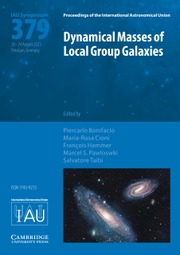Article contents
Formation of young massive clusters from turbulent molecular clouds
Published online by Cambridge University Press: 31 March 2017
Abstract
We simulate the formation and evolution of young star clusters from turbulent molecular clouds using smoothed-particle hydrodynamics and direct N-body methods. We find that the shape of the cluster mass function that originates from an individual molecular cloud is consistent with a Schechter function with power-law slopes of β = −1.73. The superposition of mass functions turn out to have a power-law slope of < −2. The mass of the most massive cluster formed from a single molecular cloud with mass M g scales with 6.1 M 0.51 g. The molecular clouds that tend to form massive clusters are much denser than those typical found in the Milky Way. The velocity dispersion of such molecular clouds reaches 20km s−1 and it is consistent with the relative velocity of the molecular clouds observed near NGC 3603 and Westerlund 2, for which a triggered star formation by cloud-cloud collisions is suggested.
Information
- Type
- Contributed Papers
- Information
- Proceedings of the International Astronomical Union , Volume 12 , Symposium S316: Formation, evolution, and survival of massive star clusters , August 2015 , pp. 25 - 30
- Copyright
- Copyright © International Astronomical Union 2017
References
- 1
- Cited by

